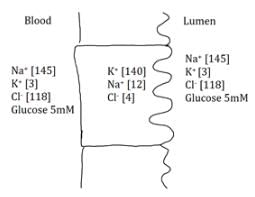Test: Transport across a Cell Membrane - Grade 11 MCQ
10 Questions MCQ Test - Test: Transport across a Cell Membrane
The nephron reabsorbs glucose through a sodium / glucose transporter. What sort of transporter is it?
What cell membrane property in the nephron capillaries allows small molecules to pass through?
Cholera affects millions of people around the world. It causes diarrhea, which can lead to dehydration and even death. Cholera toxin affects a chloride transporter that secretes chloride ion into the lumen of the small intestine. How does cholera toxin lead to dehydration?
How do potassium ions travel as they move into the cell?
Selective serotonin reuptake inhibitors (SSRIs), used to treat depression, block a specific protein in the pre-synaptic neuron to keep the neurotransmitter in the synaptic cleft for a longer period of time. What sort of protein do they block?
What sort of transporters would be required to move glucose from the blood to the lumen?

Immune system cells use damaging proteases and reactive oxygen species to destroy foreign invaders. The immune system cells are not harmed because the microbes are sequestered in vesicles. How did the invaders get to the vesicles?
Pulmonary edema occurs when fluid builds up in the interstitium between the pulmonary capillaries and the alveoli, and eventually enters the alveoli. How do you decrease the risk of pulmonary edema?
Which transport process is responsible for the movement of gases such as oxygen and carbon dioxide across the cell membrane?
Which type of transport process involves the release of large particles or substances from the cell?














